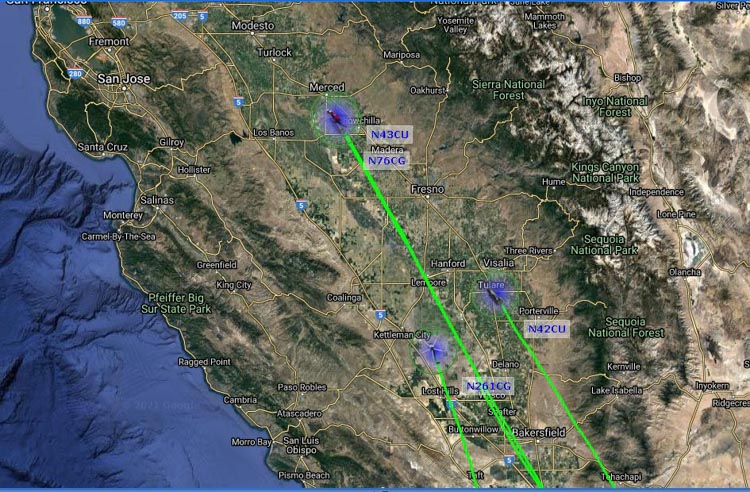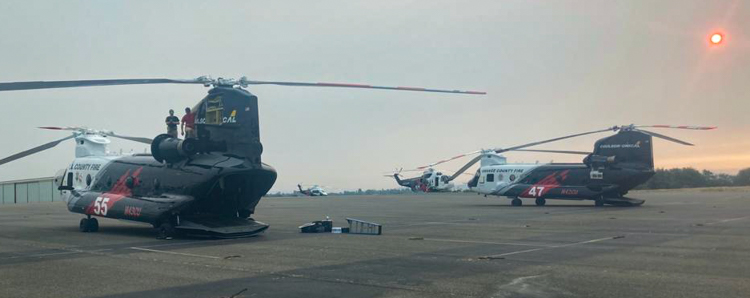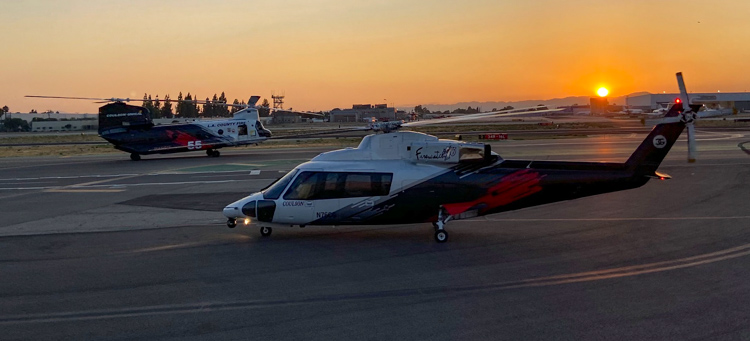
A group of large helicopters that has been on contract in three Southern California counties since June 15, called a Quick Reaction Force (QRF), has been dispatched to Northern California. They will be based just north of Jackson at Amador County Airport, also known as Westover Field.
The rapidly spreading 53,000-acre Caldor Fire is 19 miles northeast of the airport, south of Pollock Pines.

Los Angeles and Orange Counties are each supplying a 3,000-gallon CH-47D Chinook and Ventura County is sending a 1,000-gallon Sikorsky S-61. They can all drop water and hover-refill their tanks at night. The fourth member of the QRF is a Sikorsky S-76 from Orange County to provide intelligence, evaluate effectiveness of drops, and identify targets with a laser designator.
Coulson Aviation is the operator of all four helicopters. Britton Coulson, President and COO of the company, told Fire Aviation that they will also be operating one of their Cessna Citation intel aircraft to video the fleet working and map the progress.


If there so “Quick” why did it take a month for them to go up north?
Billy they are on contract with So Cal Edison for Orange, Los Angles and Ventura counties. Is PG&E flying there hawks on any of the fires.
How about the Federal Govenment and the USAF modify some of their 200+ C17s to drop water or retardant. This is not just a California problem, this is a national emergency with fires burning in many states. Night flying helicoptors and an army of C17s could put out most the fires the moment they start instead of growing.
Just curious Peter….what firefighting qualifications do you have?
Little tiny England put 500 bombers in the air to bomb one little missile factory. California, which has far more to lose, has the financial and human resources to put 500+ water bombers in the air to end the Dixie fire weeks ago. Bad politicians who have never fought a fire caused the cluster-Mess in California. Why does Sacramento avoid the OBVIOUS need for an expanded air fleet for fires? Did your town burn down? Sue Sacramento! There should have been a mile long fleet of water bombers sequencing in over the front line of that fire long ago!
Opinions are just like holes in socks and underwear; at one time or another, everyone has a lot of them.
I was in Southern California (Orange County) last night and this morning. Heavy drizzle and a touch of rain here and there. Sun came about late afternoon.
Resources go to where the fires are. Nothing new here.
WOW !
How about they are being moved there for quick IA in Northern California where the fire weather is extreme comparatively speaking to So. California’s less fire weather !
Opinions, just like a…………
I like the term “Quick Reaction Force “ and would like to see several 747’s included- it’s time we rethought our fire fighting approach and used our Cal-Fire Army to deal with our over abundance of fuel in the winter time while using a massive air assault of large fixed wing air craft to drawn out potential fire threats.
This Nation and our State has foolishly ignored the Safety and Effectiveness of ULFA in fighting Wildland Interface Conflagrations — the current Fire Service Leadership is obviously failing when fires are lasting more than 3 months!!!
IMO, these ac should be made available for IA as a “MQRF” (Moderately), where the IA is predicted to be heavy (lightning activity?). Sure, use them on a large fire, but available for IA as a group. (Task Force? Herd? Gaggle?)
> (Task Force? Herd? Gaggle?)
It’s a cluster of helicopters.
Multiple rotor-wing aircraft are termed a Vortex of Helicopters.
A herd of gaggles?
Thank you all for perpetuating the light heartedness. And it’s flock.
MRB’s are utterly useless and a total waste of time and exposure. This is especially true in a fire of this size, in this fuel type and with these kinds or ERC’s, low fuel moistures and exhibited fire behavior (a 99th percentile event).
Helicopter pilots and tanked helicopters drop suppressants (water). The tanks are designed to drop suppressants and the pilots are primarily trained for that mission. Using a rotor to drop retardant out of an MRB onto this fire is about as useful as having a fixed wing drop those ridiculous 250gal cubees, it’s a fools errand with massive exposure and consequences…especially AT NIGHT.
Look, this fire is way beyond IA. At this point, with this kind or fire behavior, it’s
beyond the capabilities of a VLAT (50 VLATS) so why on earth would anybody think a few rotors dropping a narrow coverage level 25 for 100′ is gonna make the slightest dent? Seriously?
I guarantee that these drops will be minimally effective, if at all. Use the ships to drop water with an exclusive mission of structure protection and maximize the capability. I’m tired of the “MRB Fairy” showing up.
Archie, MRBs are certainly useful in many circumstances, particularly for fixed wing (SEAT) operations at close-by airstrips to reduce reload time.
The rest of your post though is dead-on accurate. Helicopter drop patterns using retardant are excessive at the best of times, even the tanked aircraft. It’s a grossly expensive and inefficient method of delivering a long-term product by day. Factor in the decreased safety margins and slower turn times at night, well…
The use of helicopters in wildfire ops is generally run very poorly, especially on these extended campaign-style fires. Too often, aircraft are relied upon to stop/slow the spread of vigorous fire without ground resources backing them up concurrently. Even greater scrutiny should be placed upon Type 1 helicopters. Let’s hope there are crews working underneath these machines at all times on the fireline.
Given the cost of these particular machines and the premium paid for their “enhanced” technology (whizbang gadgetry mounted inside a 50-yr old aircraft with a fancy exterior wrap let’s remember), this trio of old ladies may as well be loading up and raining thousands of Ben Franklins onto the fire – it might be a less-expensive option.
Curious as to the use of the term QRF? Is this any different to other helos on suppression contracts or agency owned?
Also Bill,
The QRF is “Night Retardant Dropping Capable” and can be used for night time retardant operations should the IMT choose to do so. PHOS-CHeK Mobile Retardant Base is assigned and is with the Operation at Jackson.